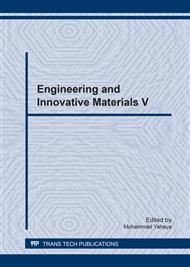p.133
p.138
p.143
p.148
p.152
p.159
p.165
p.173
p.178
Investigation of Chip and Surface Roughness when Milling AISI304 Stainless Steel
Abstract:
Stainless steel was used for many engineering applications. The optimum parameters needs to be identify to save the cutting tool usage and increase productivity. The purpose of this study is to develop the surface roughness mathematical model for AISI 304 stainless steel when milling using TiN (CVD) carbide tool. The milling process was done under various cutting condition which is cutting speed (1500, 2000 and 2500 rpm), feed rate (0.02, 0.03 and 0.04 mm/tooth) and axial depth (0.1, 0.2 and 0.3 mm). The first order model and quadratic model have been developed using Response Surface Method (RSM) with confident level 95%. The prediction models were comparing with the actual experimental results. It is found that quadratic model much fit the experimental result compare to linear model. In general, the results obtained from the mathematical models were in good agreement with those obtained from the machining experiments. Besides that, it is shown that the influence of cutting speed and feed rate are much higher on surface roughness compare to depth of cut. The optimum cutting speed, feed rate and axial depth is 2500 rpm, 0.0212 mm/tooth and 0.3mm respectively. Besides that, continues chip is produced at cutting speed 2500 rpm meanwhile discontinues chip produced at cutting speed 1500 rpm.
Info:
Periodical:
Pages:
152-158
Citation:
Online since:
March 2017
Authors:
Keywords:
Price:
Сopyright:
© 2017 Trans Tech Publications Ltd. All Rights Reserved
Share:
Citation:


